Hyundai Tucson
The Hyundai Tucson (Korean: 현대 투싼, romanized: Hyeondae Tussan) (pronounced Tu-són) is a compact crossover SUV (C-segment) produced by the South Korean manufacturer Hyundai since 2004. In the brand's lineup, the Tucson fits below the Santa Fe, and above the Kona and Creta. It is named after the city of Tucson, Arizona. The second-generation model has been marketed as the Hyundai ix35 in several markets, including Europe, Australia and China, before reverting back to Tucson for the third-generation.
| Hyundai Tucson | |
|---|---|
_in_Aachen_June_2017_(cropped).jpg.webp) | |
| Overview | |
| Manufacturer | Hyundai |
| Also called | Hyundai ix35 (2009–2015) |
| Production | 2004–present |
| Model years | 2005–present |
| Body and chassis | |
| Class | Compact crossover SUV (C) |
| Body style | 5-door SUV |
| Layout | Front engine, front-wheel-drive Front engine, all-wheel-drive |
The Tucson is the best-selling Hyundai SUV model, with more than 7 million units sold globally since it launched in 2004. Of these, 1.4 million units have been sold in Europe.[1]
First generation (JM; 2004)
| First generation (JM) | |
|---|---|
 | |
| Overview | |
| Also called | Hyundai JM |
| Production |
|
| Assembly |
|
| Body and chassis | |
| Related | |
| Powertrain | |
| Engine | |
| Transmission | |
| Dimensions | |
| Wheelbase | 2,630 mm (103.5 in) |
| Length | 4,325 mm (170.3 in) |
| Width | 1,795 mm (70.7 in) |
| Height | 1,730 mm (68.1 in) |
| Curb weight | 1,470–1,529 kg (3,241–3,371 lb)[2][3][4][5] |
.jpg.webp)
The first-generation Tucson was launched in 2004.[6] It shared its Hyundai Elantra-based platform with the second-generation Kia Sportage.
North America

In the U.S., the Tucson was offered in base GLS, mid-line SE, and top-tier Limited (formerly LX) trim levels for 2007 models. Earlier 2005 and 2006 models were offered as GL/GLS/Limited. Standard equipment included air conditioning, six airbags, electronic stability control, a CD player, alloy wheels, remote keyless entry, and premium cloth seats. The SE added to the roster with contrasting gray body cladding, a different alloy design, an AM/FM/Cassette/CD as well as fog lights and a front windshield wiper de-icing grid. The Limited added leather seating surfaces, a 6-disc in dash CD changer, body-colored cladding, automatic climate control, and heated seats. The SE and Limited were only available with the 2.7 L V6. The GLS came only with the 2.0-liter four-cylinder.
The Tucson offers modest cargo space but its easy-to-fold seats can expand this volume so they lie flat. Even the front passenger seat folds flat for extra-long cargo.
Safety
There are dual-stage frontal impact airbags, torso side-impact airbags built into the front seats, and curtain airbags for side-impact protection for front and rear passengers.
2009 Hyundai Tucson by the U.S. National Highway Traffic Safety Administration (NHTSA)[7]
- Frontal Rating (Driver):





- Frontal Rating (Passenger):





- Side Rating (Driver):





- Side Rating (Passenger):





Model year changes
Changes for 2006 were minimal. The LX became the Limited and got color-coded cladding, automatic climate control, and a high-performance sound system. The GLS retained the gray cladding but 'HYUNDAI' is no longer branded into the cladding on the front doors. The GLS also got improved cloth seats with the option of a heating element. Both GLS and Limited got redesigned alloy wheels. The base GL remained unchanged.
Changes for 2007 were also minimal. The GL and GLS trims were renamed to GLS and SE, respectively, to match the standard for all new Hyundai vehicles. The SE comes with a sport utility rack, has 4 wheel drive, and is a 6 cylinder engine.
2009 Tucsons saw minor restyling and trim changes.
Tucson FCEV
.JPG.webp)
The Tucson Fuel Cell Electric Vehicle (FCEV) is a test fuel cell vehicle for Hyundai's 2nd generation hydrogen fuel cell. The vehicle includes an 80 kW electric motor by Enova Systems of Torrance, California, UTC Fuel Cells by South Windsor, Connecticut, 152V battery co-developed by Hyundai Motor Co. and LG Chem in Seoul, Korea, 152 litres (33 imp gal; 40 US gal) hydrogen storage tanks developed by Dynetek Industries of Calgary, Alberta, Canada. The vehicle has range of 300 kilometres (186.4 mi) and top speed of 150 km/h (93 mph).[8]
The vehicle was unveiled in 2005 at the Los Angeles Auto Show[9] and completed a 4,300-mile (6,900 km) journey as part of the Hydrogen Road Tour in 2008.[10]
International markets
In Japan, the Hyundai Tucson was sold as the Hyundai JM until November 2009.[11] The Tucson was also sold in Europe, but not EuroNCAP tested.
A facelifted version of the first generation exclusive to China was produced by Beijing Hyundai. The second generation Tucson was renamed to ix35 in China and Brazil, and later became an independent model while the Tucson name returned with the introduction of the third generation.
Powertrain
| Model | Years | Transmission | Power@rpm | Torque@rpm | 0–100 km/h (0–62 mph) (Official) | Top speed |
|---|---|---|---|---|---|---|
| Petrol | ||||||
| Beta II 2.0 | 2004–2009 | 5-speed manual 4-speed automatic | 142 PS (104 kW; 140 hp) @ 6000 rpm | 18.8 kg⋅m (184 N⋅m; 136 lbf⋅ft) @ 4500 rpm | 10.4s (FWD manual) 11.3s (AWD manual) | 180 km/h (112 mph) (FWD manual) 174 km/h (108 mph) (FWD automatic) 174 km/h (108 mph) (AWD manual) |
| Delta 2.7 | 4-speed automatic | 175 PS (129 kW; 173 hp) @ 6000 rpm | 24.6 kg⋅m (241 N⋅m; 178 lbf⋅ft) @ 4000 rpm | 10.5s | 180 km/h (112 mph) | |
| Diesel | ||||||
| RA 420 2.0 CRDi | 2004–2009 | 5-speed manual 4-speed automatic | 113 PS (83 kW; 111 hp) @ 4000 rpm | 25 kg⋅m (245 N⋅m; 181 lbf⋅ft) @ 1800-2500 rpm | 13.1s (FWD manual) 13.8s (AWD manual) 15.1s (FWD automatic) 16.1s (AWD automatic) | 168 km/h (104 mph) (manual) 162 km/h (101 mph) (automatic) |
| 2006–2009 | 6-speed manual 4-speed automatic | 140 PS (103 kW; 138 hp) @ 4000 rpm 150 PS (110 kW; 148 hp) @ 4000 rpm | 31.1 kg⋅m (305 N⋅m; 225 lbf⋅ft) @ 1800-2500 rpm | 11.1s (FWD manual) 12.0s (AWD manual) 12.8s (FWD automatic) | 178 km/h (111 mph) (FWD manual) 177 km/h (110 mph) (AWD manual) 175 km/h (109 mph) (FWD automatic) | |

Reception
The Hyundai Tucson received accolades from Canadian Car of the Year Best New Crossover award for 2005. It was named as one of the most reliable vehicles from the 2009 Consumer Reports reliability survey.[12]
Second generation (LM; 2009)
| Second generation (LM) | |
|---|---|
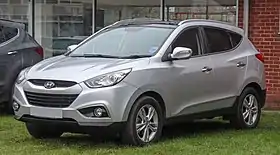 | |
| Overview | |
| Also called | Hyundai ix35 |
| Production | 2009–2015 2010–present (Brazil) |
| Model years | 2010–2015 (North America) |
| Assembly |
|
| Designer | |
| Body and chassis | |
| Related | |
| Powertrain | |
| Engine | |
| Transmission | |
| Dimensions | |
| Wheelbase | 2,640 mm (103.9 in) |
| Length | 4,475 mm (176.2 in) |
| Width | 1,850 mm (72.8 in) |
| Height | 1,645–1,685 mm (64.8–66.3 in) |
| Curb weight | 1,425–1,580 kg (3,142–3,483 lb) |
In most markets outside South Korea and North America, the Hyundai Tucson name (also known as the "Hyundai Tucson ix" in Korea) was retired in favor of Hyundai ix35.[16][17] Vehicles sold in the North America and several other regions continued to be called Tucson.[18] The ix35 was unveiled at the 2009 Frankfurt Motor Show.[19] The power output, fuel-efficiency, comfort and safety features was claimed to have been all upgraded. Known by the project name LM, it took 36 months and 280 billion won (approx. US$225 million) to develop.[20][21]
The ix35's styling was reported to be based on Hyundai ix-onic concept.[22] The ix35 was penned by Hyundai designer Cha Il-Hoei in 2007, under the guidance of former BMW designer Thomas Bürkle at Hyundai's Russelsheim design studio in Germany and continues the company's styling language, marketed as "fluidic sculpture".[23][24] The compact crossover vehicle has sweeping coupe-like lines, a premium vehicle feel and comes with features unavailable on its predecessor.
_Elite_wagon_02.jpg.webp) 2010 Hyundai ix35 Elite (pre-facelift; Australia)
2010 Hyundai ix35 Elite (pre-facelift; Australia)_Active_wagon_02.jpg.webp) 2010 Hyundai ix35 Active (pre-facelift; Australia)
2010 Hyundai ix35 Active (pre-facelift; Australia)_SE_wagon_(2018-08-06)_01.jpg.webp) 2014 Hyundai ix35 SE (facelift; Australia)
2014 Hyundai ix35 SE (facelift; Australia)_SE_wagon_(2018-08-06)_02.jpg.webp) 2014 Hyundai ix35 SE (facelift; Australia)
2014 Hyundai ix35 SE (facelift; Australia)_%E2%80%93_Heckansicht%252C_5._April_2014%252C_D%C3%BCsseldorf.jpg.webp) Hyundai ix35 FIFA World Cup Edition (facelift; Germany)
Hyundai ix35 FIFA World Cup Edition (facelift; Germany) Hyundai Tucson ix (facelift; South Korea)
Hyundai Tucson ix (facelift; South Korea) Hyundai Tucson ix (facelift; South Korea)
Hyundai Tucson ix (facelift; South Korea) Hyundai ix35 FCEV
Hyundai ix35 FCEV
United States
The Tucson sold in the United States came in three trims: GL, GLS and Limited, with All-Wheel Drive available for GLS and Limited trims. The GL comes with a standard manual transmission, but a 6-speed automatic transmission is available and is standard on GLS and Limited. Features include available steering wheel-mounted audio controls, hands-free Bluetooth phone connectivity, navigation system, and a standard iPod interface system including iPod cable. An array of advanced safety equipment is standard, including Hill Start Assist Control and Downhill Brake Control. A Proximity Key and Push Button Start system is available in the Korean market but not the North American. The North American version uses a different gauge cluster design than the Korean version.
The 2011 Tucson offered in the U.S. a new GL trim which replaces the 2010 GLS model as Tucson's base trim. The GL is powered by a new 2.0-liter 4-cylinder engine mated to either a five-speed manual or an available six-speed automatic transmission in order to obtain better fuel economy than the 2.4-liter engine. The 2011 GLS trim includes the features of the 2010 "Popular Equipment Package" and an automatic transmission as standard equipment. Limited models now include standard electrochromatic mirrors with Homelink and has received Sachs dampeners to provide a smoother ride. The electronic stability control and motor driven power steering systems have been enhanced for improved performance. All AWD models now receive standard heated seats. This model was a prominent vehicle used by the survivors in The Walking Dead (TV series).
2014 model Tucson for North America have been upgraded with GDI direct injected Theta II engines that obtain more power and better emissions, LED tail/head lights, more stylish alloy rim designs, and a few minor improvements to the interior/audio system.
 2010 Hyundai Tucson GLS (front view)
2010 Hyundai Tucson GLS (front view) 2010 Hyundai Tucson GLS (rear view)
2010 Hyundai Tucson GLS (rear view)
China
In China, the first generation Tucson was sold alongside the ix35, and was replaced by the third generation Tucson directly while the ix35 spawned its own successor, the ix35 II. The Hyundai ix35 II was revealed on the 2017 Shanghai Auto Show in China; it was available to the Chinese car market in Q3 2017.[25]
 Front view (facelift)
Front view (facelift)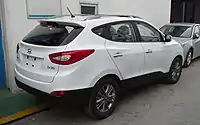 Rear view (facelift)
Rear view (facelift)
Powertrain
The Tucson/ix35 is available with several engines: an all-new 2.0-litre diesel R engine, one of two Theta-II petrol engine variants (2.0-litre or 2.4-litre), 1.7-litre UII diesel and 1.6-litre Gamma GDI petrol. The later two only in Europe. The automatic transmission is Hyundai’s all-new six-speed design. The manual transmissions available in Europe is a 6-speed for 1.7-litre and 2.0-litre diesels and 1.6 Gamma and a 5-speed for 2.0 Theta. The 2.0-liter diesel engine, available outside of North America, meets the Euro-5 emissions standards and achieves 6.5 l/100 km (15.4 km/l; 36.2 mpg‑US) fuel economy with maximum power output of 184 hp (187 PS; 137 kW). The 2.0-litre petrol engine has a fuel economy of 8.5 l/100 km (11.8 km/l; 27.7 mpg‑US) with 166 hp (168 PS; 124 kW). In South Korea, the diesel engine is offered in both front-wheel-drive and all-wheel drive configurations, while the 2.0-litre petrol engine is available only in front-wheel-drive.
The North American versions are powered by either the 2.0-litre producing 165 hp (167 PS; 123 kW) or a 2.4-liter four-cylinder petrol engine producing 176 hp (178 PS; 131 kW) mated to the six-speed automatic transmission. The 2.4-litre engine makes almost the same power as the previous generation V6 engine while managing 20% better fuel economy than the previous generation four-cylinder.[26]
| Model | Years | Transmission | Power@rpm | Torque@rpm | 0–100 km/h (0–62 mph) (Official) | Top Speed |
|---|---|---|---|---|---|---|
| Petrol | ||||||
| Gamma II 1.6 GDi | 2009–2015 | 6-speed manual | 135 PS (99 kW; 133 hp) @ 6300 rpm | 16.7 kg⋅m (164 N⋅m; 121 lbf⋅ft) @ 4850 rpm | 11.1s | 178 km/h (111 mph) |
| Theta II 2.0 MPi | 5-speed manual 6-speed automatic | 166 PS (122 kW; 164 hp) @ 6200 rpm | 20.1 kg⋅m (197 N⋅m; 145 lbf⋅ft) @ 4600 rpm | 10.4s (FWD Manual) 10.7s (AWD Manual) 10.6s (FWD Automatic) 11.2s (AWD Automatic) | 184 km/h (114 mph) (FWD Manual) 182 km/h (113 mph) (AWD Manual) 182 km/h (113 mph) (FWD Automatic) 180 km/h (112 mph) (AWD Automatic) | |
| Nu 2.0 GDi | 2013–2015 | 6-speed manual 6-speed automatic | 166 PS (122 kW; 164 hp) @ 6200 rpm | 20.9 kg⋅m (205 N⋅m; 151 lbf⋅ft) @ 4000 rpm | 10.4s (FWD Manual) 10.7s (AWD Manual) 10.4s (FWD Automatic) 11.0s (AWD Automatic) | 196 km/h (122 mph) (FWD Manual) 195 km/h (121 mph) (AWD Manual) 183 km/h (114 mph) (FWD Automatic) 181 km/h (112 mph) (AWD Automatic) |
| Theta II 2.4 MPi | 2009–2015 | 6-speed automatic | 177 PS (130 kW; 175 hp) @ 6000 rpm | 23.1 kg⋅m (227 N⋅m; 167 lbf⋅ft) @ 4000 rpm | 10.0s | 185 km/h (115 mph) |
| Diesel | ||||||
| U II 1.7 CRDi | 2009–2015 | 6-speed manual | 116 PS (85 kW; 114 hp) @ 4000 rpm | 26.5 kg⋅m (260 N⋅m; 192 lbf⋅ft) @ 1250–2750 rpm | 12.4s | 173 km/h (107 mph) |
| R II 2.0 CRDi | 6-speed manual 6-speed automatic | 136 PS (100 kW; 134 hp) @ 4000 rpm | 32 kg⋅m (314 N⋅m; 231 lbf⋅ft) @ 1800–2500 rpm | 10.8s (FWD Manual) 11.3s (AWD Manual) 9.8s (AWD Automatic) | 182 km/h (113 mph) (FWD Manual) 181 km/h (112 mph) (AWD Manual) 195 km/h (121 mph) (AWD Automatic) | |
| 184 PS (135 kW; 181 hp) @ 4000 rpm | 40 kg⋅m (392 N⋅m; 289 lbf⋅ft) @ 1800–2500 rpm (Manual) 39 kg⋅m (382 N⋅m; 282 lbf⋅ft) @ 1800–2500 rpm (Automatic) | 9.4s (FWD Manual) 10.0s (AWD Manual) 9.8s (AWD Automatic) | 195 km/h (121 mph) (FWD Manual) 194 km/h (121 mph) (AWD Manual) 195 km/h (121 mph) (AWD Automatic) | |||
Safety
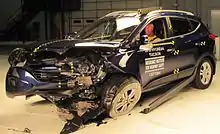
The second-generation Hyundai Tucson earned 'Top Safety Pick' award from Insurance Institute for Highway Safety (IIHS) in the U.S.[27]
| Moderate overlap frontal offset | Good |
| Small overlap frontal offset | Poor |
| Side impact | Good |
| Roof strength | Good |
Third generation (TL; 2015)
| Third generation (TL) | |
|---|---|
 | |
| Overview | |
| Production | 2015–present |
| Model years | 2016–2021 (North America) |
| Assembly |
|
| Designer | Peter Schreyer |
| Body and chassis | |
| Related | |
| Powertrain | |
| Engine | |
| Transmission | |
| Dimensions | |
| Wheelbase | 2,670 mm (105.1 in) |
| Length | 4,475 mm (176.2 in) 4,545 mm (178.9 in) (China) |
| Width | 1,850 mm (72.8 in) |
| Height | 1,645 mm (64.8 in) 1,670 mm (65.7 in) (China) |
| Curb weight | 1,488–1,702 kg (3,280–3,752 lb) |
On February 17, 2015, Hyundai released the first details about its next-generation Tucson ahead of the crossover's official debut at the Geneva Motor Show on March 3, 2015. This model arrived in showrooms in the second half of 2015, as a 2016 model year. For this generation, Hyundai reverted the ix35 nameplate, changing it back to Tucson globally.[35][36][37]
The third-generation Tucson measures 65 mm (2.6 in) longer and 30 mm (1.2 in) wider than its predecessor, while riding on a 30 mm (1.2 in) longer wheelbase. Rear storage space is also larger, with seats-up capacity growing from 465 to 513 litres.
North America
Revealed in April 2015 for the 2016 model year, the North American market Tucson was offered with a choice of two engines, a 2.0-liter direct-injection four-cylinder delivering 164 hp (166 PS; 122 kW) and 151 lb⋅ft (205 N⋅m; 20.9 kg⋅m) of torque with a 6-speed automatic transmission, and a 1.6-liter turbocharged engine with 175 hp (177 PS; 130 kW) and 195 lb⋅ft (264 N⋅m; 27.0 kg⋅m) of torque paired with a 7-speed dual-clutch transmission. Both engines available in front- and all-wheel drive versions.[38] Available in July 2015, the 2016 Hyundai Tucson was available in four trim levels: SE, Eco, Sport and Limited.[39]
Australia
The Tucson was revealed in the country in August 2015. At launch, the Tucson was offered with two petrol engines and one diesel, along with 6-speed manual, 6-speed auto and 7-speed dual-clutch auto transmissions. The 2.0-litre petrol engines include the 2.0-litre GDi Nu petrol engine, while it was also offered alongside the older 2.0-litre MPi version of the Nu engine. Other engines offered are the 1.6-litre T-GDi turbocharged petrol engine, and a turbocharged 2.0-litre R-Series diesel engine. Models with the 2.0-litre GDi engine were sourced from South Korea, while the 2.0 MPi, 1.6 T-GDi and 2.0 R-Series variants were imported from the Czech Republic.[40]
At its introduction, Hyundai Australia was confident that the name switch from ix35, back to Tucson, will not have a negative impact on sales or marketing despite the ix35 status as a top-seller in its segment.[36]
_Active_X_2WD_wagon_(2018-09-17)_01.jpg.webp) 2015 Hyundai Tucson Active X (Australia; pre-facelift)
2015 Hyundai Tucson Active X (Australia; pre-facelift)_Active_X_2WD_wagon_(2018-09-17)_02.jpg.webp) 2015 Hyundai Tucson Active X (Australia; pre-facelift)
2015 Hyundai Tucson Active X (Australia; pre-facelift)_Elite_CRDi_AWD_wagon_(2015-10-10)_03.jpg.webp) 2015 Hyundai Tucson (Australia; pre-facelift)
2015 Hyundai Tucson (Australia; pre-facelift)
2019 refresh
First shown at the 2018 New York Auto show, the Hyundai Tucson for the 2019 model year received a facelift and significant changes to the powertrain options. Exterior updates included a new cascade grille, reshaped hood and tailgate design, rectangular fuel door, new rim designs, and an updated LED headlight design for higher trim levels. The interior received a major update to include a newly designed dash with lower centrally-placed air vents and a high-mounted head unit display. A new safety feature named Driver Attention Warning (DAW) system is standard across all trim levels, and both the Lane Keeping Assist (LKA) departure/correction system and Front Collision Avoidance Assist (FCA) system are now also standard across all trim levels.
The manual and dual clutch transmission options were dropped in favor of the 6-speed Shiftronic automatic used in previous model years and is available with Front-Wheel-Drive (FWD) or All-Wheel-Drive (AWD). The 2.0-liter Nu GDi engine continues in the SE and Value trim levels but for other trims the 1.6-liter I4 turbocharged engine was dropped and replaced by a 2.4-liter I4 GDi naturally aspirated engine which produces 181 hp (184 PS; 135 kW) at 6,000 rpm and 175 lb⋅ft (237 N⋅m; 24.2 kg⋅m) with a slight loss in fuel economy.[41]
For the Chinese market, the Tucson was given an alternate facelift for the 2019 model year with the single model name known as 280TGDi and 6 separate trim levels. The 1.6-litre G4FJ engine is available paired to a 7-speed dual-clutch transmission.[42]
In spring 2019, Hyundai started selling the sportier variant N-Line.[43]
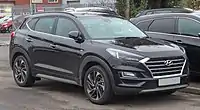 2018 Hyundai Tucson Premium SE (UK; facelift)
2018 Hyundai Tucson Premium SE (UK; facelift) 2018 Hyundai Tucson Premium SE (UK; facelift)
2018 Hyundai Tucson Premium SE (UK; facelift) Interior (Europe; facelift)
Interior (Europe; facelift)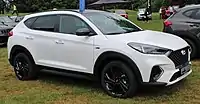 Hyundai Tucson N-Line (UK)
Hyundai Tucson N-Line (UK) 2019 Hyundai Tucson (China; facelift)
2019 Hyundai Tucson (China; facelift)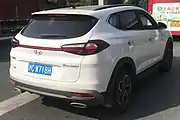 2019 Hyundai Tucson (China; facelift)
2019 Hyundai Tucson (China; facelift)
Powertrain
During the Geneva Motor Show, Hyundai also unveiled two concept variants, a Tucson hybrid electric and a diesel-powered plug-in hybrid. The 48V Hybrid combines a 2.0-liter diesel model with 134 hp (100 kW) and a six-speed manual transmission along with a 14 hp (10 kW) electric motor; combined system performance is 148 hp (110 kW) and 413 N·m (305 lb-ft) of torque. This boosts system power by 10% while emitting only 109 g/km CO
2. The concept plug-in-hybrid is also based on the all-new Tucson platform and is equipped with a 1.7-liter diesel engine and a seven-speed dual-clutch transmission. The engine generates 113 hp (85 kW) and is accompanied by a 67 hp (50 kW) electric motor and a 10.7 kWh lithium-ion polymer battery, which delivers an all-electric range of more than 50 km (31 mi). Combined system output is a maximum of 180 hp (135 kW) with 474 N·m (350 lb-ft) of torque, with estimated CO
2 emissions of less than 48 g/km.[44]
| Model | Years | Transmission | Power | Torque | 0-100 km/h (0-62 mph) (Official) |
Top speed |
|---|---|---|---|---|---|---|
| Petrol | ||||||
| Gamma II 1.6 GDi | 2015–present | 6-speed manual 6-speed automatic |
132 PS (97 kW; 130 hp) @ 6300 rpm | 16.4 kg⋅m (161 N⋅m; 119 lbf⋅ft) @ 4850 rpm |
|
|
| Gamma II 1.6 T-GDi | 6-speed manual 7-speed dual clutch automatic |
177 PS (130 kW; 175 hp) @ 5500 rpm | 27 kg⋅m (265 N⋅m; 195 lbf⋅ft) @ 1500-4500 rpm |
|
| |
| Nu 2.0 MPi | 6-speed manual 6-speed automatic |
155 PS (114 kW; 153 hp) @ 6200 rpm | 19.6 kg⋅m (192 N⋅m; 142 lbf⋅ft) @ 4000 rpm |
|
186 km/h (116 mph) (FWD Manual) 181 km/h (112 mph) (FWD Automatic) 184 km/h (114 mph) (AWD Manual) 180 km/h (112 mph) (AWD Automatic) | |
| Nu 2.0 GDi | 6-speed automatic | 163 PS (120 kW; 161 hp) @ 6200 rpm | 20.8 kg⋅m (204 N⋅m; 150 lbf⋅ft) @ 4500 rpm | |||
| Theta II 2.0 MPi | 165 PS (121 kW; 163 hp) @ 6000 rpm | 20.1 kg⋅m (197 N⋅m; 145 lbf⋅ft) @ 4000 rpm | ||||
| Theta II 2.4 MPi | 6-speed manual 6-speed automatic |
176 PS (129 kW; 174 hp) @ 6000 rpm | 23.2 kg⋅m (228 N⋅m; 168 lbf⋅ft) @ 4000 rpm | |||
| Theta II 2.4 GDi | 6-speed automatic | 184 PS (135 kW; 181 hp) @ 6000 rpm | 24.2 kg⋅m (237 N⋅m; 175 lbf⋅ft) @ 4000 rpm | 9.6s | 192 km/h (119 mph) | |
| Diesel | ||||||
| 1.6 U II CRDi | 2019–present | 6-speed manual 7-speed dual clutch automatic |
115 PS (85 kW; 113 hp) @ 4000 rpm 136 PS (100 kW; 134 hp) @ 4000 rpm |
28.6 kg⋅m (280 N⋅m; 207 lbf⋅ft) @ 1500-2750 rpm 32.6 kg⋅m (320 N⋅m; 236 lbf⋅ft) @ 2000-2250 rpm |
|
|
| 1.7 U II CRDi | 2015–2018 | 6-speed manual | 116 PS (85 kW; 114 hp) @ 4000 rpm | 28.6 kg⋅m (280 N⋅m; 207 lbf⋅ft) @ 1250-2750 rpm | 13.7s | 176 km/h (109 mph) |
| 7-speed dual clutch automatic | 141 PS (104 kW; 139 hp) @ 4000 rpm | 34.7 kg⋅m (340 N⋅m; 251 lbf⋅ft) @ 1750-2500 rpm | 10.6s | 186 km/h (116 mph) | ||
| 2.0 R II CRDi | 2015–2018 | 6-speed manual | 136 PS (100 kW; 134 hp) @ 2750-4000 rpm | 38 kg⋅m (373 N⋅m; 275 lbf⋅ft) @ 1500-2500 rpm | 10.6s | 187 km/h (116 mph) |
| 2019–present | 6-speed manual 8-speed automatic |
185 PS (136 kW; 182 hp) @ 4000 rpm | 40.8 kg⋅m (400 N⋅m; 295 lbf⋅ft) @ 1750-2750 rpm | 9.9s (Manual) 9.5s (Automatic) |
201 km/h (125 mph) | |
Fourth generation (NX4; 2020)
| Fourth generation (NX4) | |
|---|---|
_IMG_3676.jpg.webp) | |
| Overview | |
| Production | 2020–present |
| Model years | 2022–present (North America) |
| Assembly | South Korea: Ulsan Czech Republic: Nošovice (HMMC) China: Beijing (Beijing Hyundai) |
| Designer | Sangyup Lee |
| Powertrain | |
| Engine |
|
| Electric motor | Permanent magnet synchronous |
| Transmission | 6-speed manual 6-speed clutchless manual 6-speed automatic 8-speed automatic 6-speed DCT 7-speed DCT |
| Hybrid drivetrain | 48V Mild hybrid (MHEV) Power-split hybrid (HEV) Plug-in Hybrid (PHEV) |
| Dimensions | |
| Wheelbase | 2,680 mm (105.5 in) (SWB) 2,755 mm (108.5 in) (LWB) |
| Length | 4,500 mm (177.2 in) (SWB) 4,630–4,670 mm (182.3–183.9 in) (LWB) |
| Width | 1,865 mm (73.4 in) |
| Height | 1,650–1,665 mm (65.0–65.6 in) |
| Curb weight | 1,495–1,695 kg (3,296–3,737 lb) |
On September 14, 2020, Hyundai revealed the fourth generation Tucson. The all-new model features Hyundai's "jewel-like" grille, with geometric daytime running lights integrated in its design. Hyundai’s design team, led by Sangyup Lee, its senior vice president and head of Hyundai Global Design Center, has reshaped the Tucson with bulging fenders, angled wheel wells, a level roofline and short overhangs.[46]
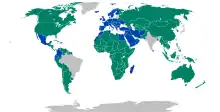
The fourth-generation Tucson is offered with two wheelbase length for different markets to meet different customers needs and expectations in different regions, which are short-wheelbase (2,680 mm (105.5 in)), and long-wheelbase (2,755 mm (108.5 in)).[48] Most regions outside Europe, Middle East and Mexico will receive the long-wheelbase version.[49][50] In China, the long-wheelbase-only fourth-generation Tucson is marketed as the Tucson L to differentiate itself with the older model.[51]
In the interior, the new Tucson features a fully digital instrument cluster and a four-point steering wheel. It also include a vertically stacked, dual 10.25-inch full-touch screen with capacitive button and a hoodless digital gauge cluster. For the long-wheelbase version, Hyundai claimed the cargo volume will provide a 38.7 cu ft (1,096 L) of usable space.[48][52]
Europe
_IMG_3678.jpg.webp)
Continued to be produced in Hyundai Motor Manufacturing Czech, the European Tucson is solely offered with the short 2,680 mm (105.5 in) wheelbase version. The European range of the fourth-generation Tucson includes five electrified powertrain options, as well as one petrol and one diesel.
The base options are the petrol 1.6-liter T-GDi with 147 hp (149 PS; 110 kW) engine and the diesel 1.6-liter CRDi with 113 hp (115 PS; 84 kW). Both engines are also offered with a mild hybrid 48-volt technology, which include the petrol 1.6-liter T-GDi in 147 hp (149 PS; 110 kW) and 177 hp (179 PS; 132 kW) versions, and the diesel 1.6-liter CRDi with 134 hp (136 PS; 100 kW). Mild hybrid petrol models is fitted with the 6-speed Intelligent Manual Transmission (iMT) as standard.
At launch, the most powerful Tucson is the hybrid 1.6-liter T-GDi HEV, which combines the turbocharged petrol engine with a 59 hp (60 PS; 44 kW) electric motor and a 1.49 kWh lithium-ion polymer battery for a system output of 226 hp (229 PS; 169 kW). The hybrid Tucson will be offered with a 6-speed automatic and optional all-wheel-drive drivetrain. A plug-in hybrid variant based on the 1.6-liter T-GDI petrol with a combined output of 261 hp (265 PS; 195 kW) will be introduced in 2021.[53]
North America
The fourth-generation Tucson was revealed in the long-wheelbase guise for the North American market in November 2020 for the 2022 model year.[54] It will feature a new 2.5-litre 4-cylinder Smartstream petrol engine rated at 187 hp (190 PS; 139 kW) and 178 lb⋅ft (241 N⋅m; 24.6 kg⋅m) of torque. The Tucson Hybrid will also be sold in the region, bringing a combination of 1.6-litre T-GDi engine with a 44 kW electric motor. It is capable of 226 hp (229 PS; 169 kW), 258 lb⋅ft (350 N⋅m; 35.7 kg⋅m) of torque and 30 percent increase in fuel economy. A plug-in hybrid version will arrive later, powered by a 13.8-kWh battery providing 45 km (28 mi) of zero-emission range.[55]
Hyundai will produce the new Tucson in the United States due to its increasing popularity starting from 2021, despite resistance from the labor union in South Korea.[56] The Tucson will be produced alongside the Elantra, Sonata and Santa Fe in Hyundai Motor Manufacturing Alabama in Montgomery.[57][58]
China
The fourth-generation Tucson was unveiled in 2020 Guangzhou Motor Show, marketed as the Tucson L. Several exterior changes for the Chinese market include false exhaust tips in the rear.[59] Changes in the interior include a larger vertically mounted touch screen infotainment system.[60] Two Smartstream turbocharged engines will be offered, with a 1.5-liter T-GDi engine that produces 170 hp (172 PS; 127 kW), paired with a 7-speed dual-clutch transmission. Top-end models gets a 2.0-liter T-GDi unit with an 8-speed automatic transmission that generates 240 hp (243 PS; 179 kW).[61]
Powertrain
| Model | Years | Engine | Transmissions | Power | Torque | 0-100 km/h (0-62 mph) (Official) |
Top speed |
|---|---|---|---|---|---|---|---|
| Petrol engines | |||||||
| Smartstream G1.6 T-GDi 48V | 2020–present | 1,598 cc (97.5 cu in) turbocharged I4 | 6-speed manual 6-speed clutchless manual 7-speed DCT |
150 PS (110 kW; 148 hp) @ 5,500 rpm | 25.5 kg⋅m (250 N⋅m; 184 lbf⋅ft) @ 1,500-4,000 rpm | 10.3s (manual) 9.6s (DCT) |
189 km/h (117 mph) |
| Smartstream G1.6 T-GDi | 7-speed DCT | 180 PS (132 kW; 178 hp) @ 5,500 rpm | 27 kg⋅m (265 N⋅m; 195 lbf⋅ft) @ 1,500-4,000 rpm | 9.0s | 201 km/h (125 mph) | ||
| Smartstream G2.5 GDi | 2021–present | 2,497 cc (152.4 cu in) I4 | 8-speed automatic | 187 PS (138 kW; 184 hp) @ 6,100 rpm | 24.6 kg⋅m (241 N⋅m; 178 lbf⋅ft) @ 4,000 rpm | ||
| Petrol hybrid | |||||||
| Smartstream G1.6 T-GDi Hybrid | 2020–present | 1,598 cc (97.5 cu in) turbocharged I4 | 6-speed automatic 6-speed DCT |
230 PS (169 kW; 227 hp) @ 5,500 rpm | 27 kg⋅m (265 N⋅m; 195 lbf⋅ft) @ 1,500-4,000 rpm | 8.0s (FWD) 8.3s (AWD) |
193 km/h (120 mph) |
| Smartstream G1.6 T-GDi Plug-in Hybrid | 265 PS (195 kW; 261 hp) @ 5,500 rpm | ||||||
| Diesel | |||||||
| Smartstream D1.6 CRDi | 2020–present | 1,598 cc (97.5 cu in) turbocharged I4 | 6-speed manual | 115 PS (85 kW; 113 hp) @ 4,000 rpm | 28.6 kg⋅m (280 N⋅m; 207 lbf⋅ft) @ 1,500-2,750 rpm | 12.1s | 175 km/h (109 mph) |
| 7-speed DCT | 136 PS (100 kW; 134 hp) @ 4,000 rpm | 32.6 kg⋅m (320 N⋅m; 236 lbf⋅ft) @ 2,000-2,250 rpm | 11.4s–11.6s | 180 km/h (112 mph) | |||
| Smartstream D2.0 CRDi | 1,998 cc (121.9 cu in) turbocharged I4 | 8-speed automatic | 186 PS (137 kW; 183 hp) @ 4,000 rpm | 42.5 kg⋅m (417 N⋅m; 307 lbf⋅ft) @ 2,000-2,750 rpm | |||
Sales
| Calendar year | United States[67] | Europe[68][69] |
|---|---|---|
| 2004 | 7,074 | 17,664 |
| 2005 | 61,048 | 63,585 |
| 2006 | 52,067 | 60,500 |
| 2007 | 41,476 | 53,598 |
| 2008 | 19,027 | 28,275 |
| 2009 | 15,411 | 20,485 |
| 2010 | 39,594 | 53,112 |
| 2011 | 47,232 | 74,662 |
| 2012 | 48,878 | 87,963 |
| 2013 | 41,906 | 88,831 |
| 2014 | 47,306 | 93,540 |
| 2015 | 63,591 | 120,358 |
| 2016 | 89,713 | 158,113 |
| 2017 | 114,735 | 152,875 |
| 2018 | 142,263 | 137,618 |
| 2019 | 137,381 | 136,608 |
| 2020 | 123,657 |
References
- "The all-new Hyundai Tucson: a smart tech hero with a standout design". Hyundai Media Newsroom. Retrieved 2020-12-23.
- "2007 Hyundai Tucson - Specifications - Car Specs - Auto123". auto123.com. Retrieved 29 October 2018.
- "2005 Hyundai Tucson - Specifications - Car Specs - Auto123". auto123.com. Retrieved 29 October 2018.
- "2006 Hyundai Tucson - Specifications - Car Specs - Auto123". auto123.com. Retrieved 29 October 2018.
- Carfind.ca. "2007 Hyundai Tucson FWD Specifications - Winnipeg Used Cars, Winnipeg Used Trucks, Manitoba Used Cars, Manitoba Used Trucks, Used Vehicle Reviews, Safety Recalls, Used Cars for Sale in Manitoba". www.carfind.ca. Retrieved 29 October 2018.
- https://wwwb.autotrader.ca/cars/hyundai/tucson/2004/
- 2009 Hyundai Tucson NHTSA Star Rating CarsDirect.com
- "Hyundai Tucson Hybrid FCEV". Hydrogen-motors.com. 2008-10-21. Archived from the original on 2015-09-24. Retrieved 2010-09-26.
- Keegan, Walter J (2005-12-18). "L.A. Auto Show: Hyundai Tucson FCEV". Autoblog.com. Retrieved 2010-09-26.
- Abuelsamid, Sam (2008-11-19). "LA 2008: Hyundai announces Blue Drive efficiency strategy, 2010 Sonata hybrid". Green.autoblog.com. Retrieved 2010-09-26.
- "Hyundai Jm 2.7gls Especificaciones, Dimensiones e Imágenes | CAR FROM JAPAN". carfromjapan.com. Retrieved 2020-10-18.
- Consumer Reports' 2009 Annual Car Reliability Survey Archived 2009-10-31 at the Wayback Machine October 27, 2009. Reuters
- "Hyundai Tucson now CKD, priced lower from RM116k". Paul Tan's Automotive News. 2015-03-18. Retrieved 2020-12-21.
- "EUIPO - eSearch". Archived from the original on 2015-01-11.
- "Thomas Bürkle". Hyundai Motor UK Ltd. Archived from the original on 2013-10-02. Retrieved 2013-08-12.
- "First drive: Hyundai ix35". Wheels. 2010-02-23. Retrieved 2020-10-18.
- "Hyundai ix35 Unveiled". Motor1.com. Retrieved 2020-10-18.
- Edmunds Used Car Guide, (retrieved 28 July 2015).
- Abuelsamid, Sam (2009-08-18). "Frankfurt Preview: Hyundai officially teases the new Tucson *UPDATED". Autoblog.com. Retrieved 2010-09-26.
- "Hyundai Tucson ix first official images released". Motor1.com. Retrieved 2020-10-18.
- "2010 KDM Hyundai Tucson is looking California and...errr... naming Arizona". Autoblog. Retrieved 2020-10-18.
- Ramsey, Jonathon (2009-08-09). "Hyundai ix35 (i.e. the new Tucson) spotted in Sydney". Autoblog.com. Retrieved 2010-09-26.
- New Hyundai ix35 Car Archived 2011-07-08 at the Wayback Machine September 08, 2009. CarTradeIndia.com
- Made in Germany | Hyundai`s success - Designed in Germany 2009, DW-TV (Deutsche Welle)
- "Hyundai Launches The ix35 Compact SUV On The Shanghai Auto Show".
- "Hyundai Unveils Redesigned 2010 Tucson". Automoblog.net.
- https://www.iihs.org/iihs/ratings/vehicle/v/hyundai/tucson-4-door-suv/2013
- "Archived copy". Archived from the original on May 3, 2013. Retrieved May 19, 2013.CS1 maint: archived copy as title (link)
- "Com motor 1.6 turbo, New Tucson terá preço inicial de R$ 138.900". Retrieved 29 October 2018.
- "Sales Performance | IR Activities | IR | Company | Company - Hyundai Worldwide". Hyundai Motor Company. Retrieved 2020-10-04.
- AE, Rédaction (29 October 2016). "Le premier véhicule Hyundai " made in Algéria " est sorti ce samedi - Algerie Eco". Retrieved 29 October 2018.
- https://www.thecarconnection.com/overview/hyundai_tucson_2015
- https://wwwb.autotrader.ca/research/hyundai/tucson/2015/
- "Hyundai Tucson models specifications - Auto Types". www.auto-types.com. Retrieved 29 October 2018.
- 2016 Hyundai Tucson Press Release 02/17/2016. AutoBlog
- "Hyundai Tucson name change to have minimal effect | CarAdvice". CarAdvice.com. Retrieved 2020-10-18.
- "Hyundai gambles on new name". www.weeklytimesnow.com.au. 2015-08-04. Retrieved 2020-10-18.
- "Hyundai Reveals More Handsome 2016 Tucson For North America In NY". Carscoops. Retrieved 2020-12-23.
- "New 2016 Hyundai Tucson Priced From $22,700*". Carscoops. Retrieved 2020-12-23.
- "2016 Hyundai Tucson pricing and specifications | CarAdvice". CarAdvice.com. Retrieved 2020-12-23.
- Stefan Ogbac. "2019 HYUNDAI TUCSON FIRST LOOK: GOODBYE TURBOCHARGER". Motortrend.
- "Hyundai Tucson facelift for the Chinese market".
- "Hyundai Tucson 1.6 CRDi N-Line 2019 review".
- Mike Millikin (2015-03-08). "Hyundai showcasing new Tucson 48V Hybrid Concept and diesel Plug-in-Hybrid Concept at Geneva". Green Car Congress. Retrieved 2015-03-29.
- https://www.hyundai.com/worldwide/en/suv/tucson/highlights
- Oldham, Scott (2020-11-09). "2022 Hyundai Tucson Offers Daring Looks, More Power and Space". Car and Driver. Retrieved 2020-12-23.
- Davis, Brett (2020-09-15). "2021 Hyundai Tucson debuts, long wheelbase & N Line confirmed for Australia". PerformanceDrive. Retrieved 2020-12-21.
- "Hyundai Launches Dynamic New Tucson with Best-in-Segment Features and Class-Leading Capabilities". Hyundai Motors. Retrieved 2020-12-21.
- "New 2021 Hyundai Tucson priced from £28,495". Autocar. Retrieved 2020-12-21.
- "New Hyundai Tucson Offers Long And Short Wheelbases, 2 Hybrid Versions". CARGlancer. 2020-09-21. Retrieved 2020-12-21.
- "New Hyundai Tucson L Has A Misleading Name". CarBuzz. 2020-11-24. Retrieved 2020-12-21.
- "2021 Hyundai Tucson revealed". WhichCar. Retrieved 2020-12-21.
- "2021 Hyundai Tucson: European Range Detailed In All Its Electrified Glory". Carscoops. 2020-09-17. Retrieved 2020-12-21.
- Blanco, Sebastian (2020-11-09). "New 2022 Hyundai Tucson SUV Grows In Size, Capability And Aspiration". Forbes Wheels. Retrieved 2020-12-21.
- "2022 Hyundai Tucson Makes North American Debut, Tucson N Line Teased". The Car Guide. Retrieved 2020-12-21.
- "Will Hyundai Motor Be Able to Produce the Tucson SUV in the U.S.?". Businesskorea (in Korean). 2020-11-11. Retrieved 2020-12-21.
- Fiscus, Kirsten. "Hyundai bringing 2022 Tucson production to Montgomery". The Montgomery Advertiser. Retrieved 2020-12-21.
- Us, Contact; Directory, Staff; Notification, Local Project. "Hyundai to add next-gen Tucson SUV to Alabama family of vehicles". Made in Alabama. Retrieved 2020-12-21.
- "FormaCar: Hyundai stretches the new Tucson for China". www.formacar.com. Retrieved 2020-12-21.
- "El nuevo Hyundai Tucson L 2021 irrumpe en China alejándose del modelo europeo". Motor.es (in Spanish). 2020-11-25. Retrieved 2020-12-21.
- "New Hyundai Tucson L Has A Misleading Name". CarBuzz. 2020-11-24. Retrieved 2020-12-21.
- https://www.hyundai.com/kr/ko/e/vehicles/tucson/spec
- https://www.hyundai.com/kr/ko/e/vehicles/tucson-hybrid/spec
- "Hyundai Tucson".
- "TUCSON Nouvelle Génération". www.hyundai.fr. Retrieved 2020-12-21.
- "Listino e Scheda Tecnica". Hyundai (in Italian). Retrieved 2020-12-21.
- "Official Media Site - Hyundai Newsroom". www.hyundainews.com. Retrieved 29 October 2018.
- "Hyundai Tucson European sales figures". carsalesbase.com. 2014-02-10. Retrieved 2020-10-18.
- "Hyundai ix35 European sales figures". carsalesbase.com. 2014-01-29. Retrieved 2020-10-18.

_02.jpg.webp)